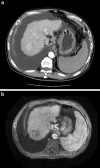Tolerance of high-intensity focused ultrasound ablation in patients with hepatocellular carcinoma
- PMID: 22699746
- PMCID: PMC3465545
- DOI: 10.1007/s00268-012-1660-7
Tolerance of high-intensity focused ultrasound ablation in patients with hepatocellular carcinoma
Abstract
Background: High-intensity focused ultrasound (HIFU) ablation is a relatively new, noninvasive way of ablation for treating hepatocellular carcinoma (HCC). Emerging evidence has shown that it is effective for the treatment of HCC, even in patients with poor liver function. There is currently no data on the safety limit of HIFU ablation in patients with cirrhosis. However, this information is vital for the selection of appropriate patients for the procedure. We analyzed HCC patients who had undergone HIFU ablation and determined the lower limit of liver function and other patient factors with which HCC patients can tolerate this treatment modality.
Methods: Preoperative variables of 100 patients who underwent HIFU ablation for HCC were analyzed to identify the risk factors in HIFU intolerance in terms of stress-induced complications. Factors that may contribute to postablation complications were compared.
Results: Thirteen (13 %) patients developed a total of 18 complications. Morbidity was mainly due to skin and subcutaneous tissue injuries (n = 9). Five patients had first-degree skin burn, one had second-degree skin burn, and three had third-degree skin burn. Four complications were grade 3a in the Clavien classification and 14 were below this grade. Univariate analysis showed that age (p = 0.022) was the only independent factor in HIFU intolerance.
Conclusions: HIFU ablation is generally well tolerated in HCC patients with cirrhosis. It is safe for Child-Pugh A and B patients and selected Child-Pugh C patients. With this new modality, HCC patients who were deemed unsalvageable by other surgical means in the past because of simultaneous Child-Pugh B or C disease now have a new hope.
Figures


Similar articles
-
Survival analysis of high-intensity focused ultrasound ablation in patients with small hepatocellular carcinoma.HPB (Oxford). 2013 Aug;15(8):567-73. doi: 10.1111/hpb.12025. Epub 2012 Dec 4. HPB (Oxford). 2013. PMID: 23458602 Free PMC article.
-
High-intensity focused ultrasound ablation: an effective bridging therapy for hepatocellular carcinoma patients.World J Gastroenterol. 2013 May 28;19(20):3083-9. doi: 10.3748/wjg.v19.i20.3083. World J Gastroenterol. 2013. PMID: 23716988 Free PMC article.
-
Comparison of radiofrequency ablation, microwave ablation and high-intensity focused ultrasound for hepatocellular carcinoma: a retrospective study.HPB (Oxford). 2025 May;27(5):607-613. doi: 10.1016/j.hpb.2025.01.003. Epub 2025 Jan 7. HPB (Oxford). 2025. PMID: 39843271
-
High intensity focused ultrasound, liver disease and bridging therapy.World J Gastroenterol. 2013 Nov 21;19(43):7494-9. doi: 10.3748/wjg.v19.i43.7494. World J Gastroenterol. 2013. PMID: 24282341 Free PMC article. Review.
-
High-intensity focused ultrasound ablation of liver tumors in difficult locations.Int J Hyperthermia. 2021 Sep;38(2):56-64. doi: 10.1080/02656736.2021.1933217. Int J Hyperthermia. 2021. PMID: 34420450 Review.
Cited by
-
Survival analysis of high-intensity focused ultrasound ablation in patients with small hepatocellular carcinoma.HPB (Oxford). 2013 Aug;15(8):567-73. doi: 10.1111/hpb.12025. Epub 2012 Dec 4. HPB (Oxford). 2013. PMID: 23458602 Free PMC article.
-
High intensity focused ultrasound (HIFU) applied to hepato-bilio-pancreatic and the digestive system-current state of the art and future perspectives.Hepatobiliary Surg Nutr. 2016 Aug;5(4):329-44. doi: 10.21037/hbsn.2015.11.03. Hepatobiliary Surg Nutr. 2016. PMID: 27500145 Free PMC article. Review.
-
Non-Thermal Liver Ablation: Existing and New Technology.Semin Intervent Radiol. 2024 Jan 24;40(6):497-504. doi: 10.1055/s-0043-1777844. eCollection 2023 Dec. Semin Intervent Radiol. 2024. PMID: 38274216 Free PMC article. Review.
-
Hong Kong consensus recommendations on the management of hepatocellular carcinoma.Liver Cancer. 2015 Mar;4(1):51-69. doi: 10.1159/000367728. Liver Cancer. 2015. PMID: 26020029 Free PMC article. Review.
-
High-intensity focused ultrasound treatment for hepatocellular carcinoma.J Med Ultrason (2001). 2024 Jun 28. doi: 10.1007/s10396-024-01469-1. Online ahead of print. J Med Ultrason (2001). 2024. PMID: 38941033 Review.
References
Publication types
MeSH terms
LinkOut - more resources
Full Text Sources
Medical
Miscellaneous

